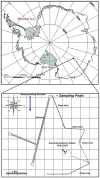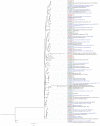Snow surface microbiome on the High Antarctic Plateau (DOME C)
- PMID: 25101779
- PMCID: PMC4125213
- DOI: 10.1371/journal.pone.0104505
Snow surface microbiome on the High Antarctic Plateau (DOME C)
Abstract
The cryosphere is an integral part of the global climate system and one of the major habitable ecosystems of Earth's biosphere. These permanently frozen environments harbor diverse, viable and metabolically active microbial populations that represent almost all the major phylogenetic groups. In this study, we investigated the microbial diversity in the surface snow surrounding the Concordia Research Station on the High Antarctic Plateau through a polyphasic approach, including direct prokaryotic quantification by flow cytometry and catalyzed reporter deposition fluorescence in situ hybridization (CARD-FISH), and phylogenetic identification by 16S RNA gene clone library sequencing and 454 16S amplicon pyrosequencing. Although the microbial abundance was low (<10(3) cells/ml of snowmelt), concordant results were obtained with the different techniques. The microbial community was mainly composed of members of the Alpha-proteobacteria class (e.g. Kiloniellaceae and Rhodobacteraceae), which is one of the most well-represented bacterial groups in marine habitats, Bacteroidetes (e.g. Cryomorphaceae and Flavobacteriaceae) and Cyanobacteria. Based on our results, polar microorganisms could not only be considered as deposited airborne particles, but as an active component of the snowpack ecology of the High Antarctic Plateau.
Conflict of interest statement
Figures







References
-
- Miteva V (2008) Bacteria in snow and glacier ice. In: Margesin R, Schinner F, Marx JC, Gerday C, editors. Psychrophiles: from biodiversity to biotechnology. Springer: Berlin. pp. 31–50.
-
- Lugg D, Shepanek M (1999) Space analogue studies in Antarctica. Acta Astronaut 44: 693–699. - PubMed
-
- Pyne SJ (2007) The extraterrestrial Earth: Antarctica as analogue for space exploration. Space Policy 23: 147–149.
-
- Liu Y, Yao T, Jiao N, Kang S, Xu B, et al. (2009) Bacterial diversity in the snow over Tibetan Plateau Glaciers. Extremophiles 13: 411–423. - PubMed
Publication types
MeSH terms
Substances
LinkOut - more resources
Full Text Sources
Other Literature Sources
Molecular Biology Databases

